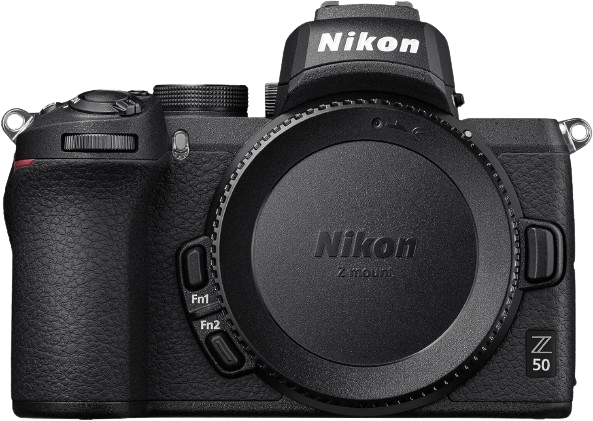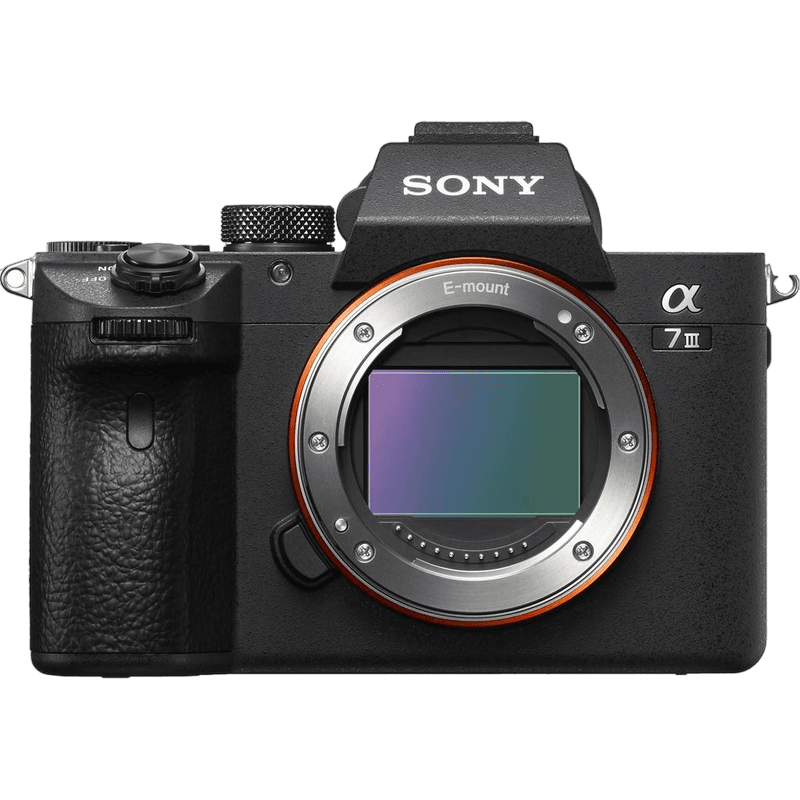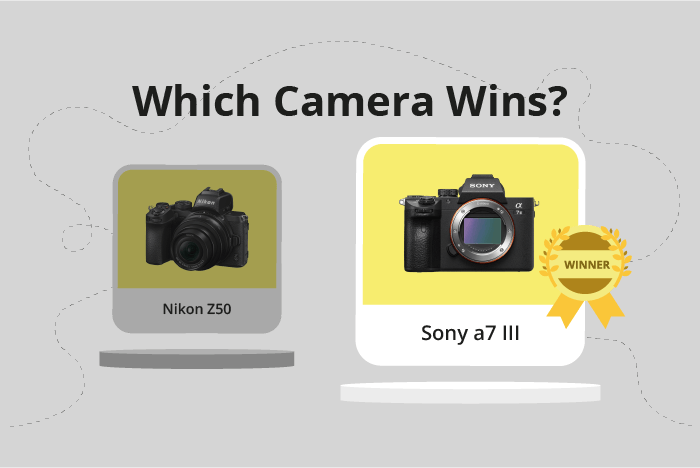Nikon Z50 vs Sony a7 III Comparison
Nikon Z50

Sony a7 III

The Sony a7 III emerges as the winner with a score of 81, compared to the Nikon Z50‘s score of 73/100. Both cameras are mirrorless and were released in 2018 and 2019, respectively. They share similar dimensions, with the Sony a7 III being slightly heavier at 650g compared to the Nikon Z50’s 450g.
The Sony a7 III’s higher score reflects its superior performance and features. Its launch price of $2000 is significantly higher than the Nikon Z50’s $859, which may suggest that it offers better quality and functionality. However, the Nikon Z50 has its advantages, such as its lighter weight, making it more portable and convenient for users.
Considering these factors, the Sony a7 III is the better choice for those seeking advanced features and performance, while the Nikon Z50 is a more budget-friendly option for users prioritizing portability.
Nikon Z50 vs Sony a7 III Overview and Optics
The Sony a7 III emerges as the winner in the optics comparison with a score of 81/100, outperforming the Nikon Z50, which scores 72/100. Both cameras share some common specifications, including a CMOS sensor, similar shooting speeds (Nikon Z50 at 11 and Sony a7 III at 10), and lens mounts designed for their respective systems (Nikon Z and Sony FE).
The Sony a7 III excels in several areas, contributing to its higher score. With 24.2 megapixels, it provides higher resolution images than the Nikon Z50’s 21 megapixels. Additionally, the Sony a7 III features a full-frame sensor, offering superior image quality and better low-light performance compared to the Nikon Z50’s APS-C sensor. The inclusion of image stabilization in the Sony a7 III also sets it apart, ensuring sharper images in various shooting conditions.
On the other hand, the Nikon Z50 holds a slight advantage in terms of shooting speed (11 fps vs. 10 fps) and its DXOMARK sensor score of 97, compared to the Sony a7 III’s score of 96. These factors, however, do not significantly impact the overall optics performance in favor of the Nikon Z50.
After examining the optics specifications and performance of both cameras, it is evident that the Sony a7 III stands out as the superior option. Its higher resolution, full-frame sensor, and image stabilization features contribute to its higher score and better overall performance. While the Nikon Z50 maintains a slight edge in shooting speed and DXOMARK sensor score, these factors do not outweigh the advantages offered by the Sony a7 III.
Nikon Z50 vs Sony a7 III Video Performance
The Nikon Z50 outperforms the Sony a7 III in video capabilities with a significant difference in their scores: 91 for the Nikon Z50 and 70 for the Sony a7 III. Both cameras share some common specifications, such as 4K maximum video resolution and 3840 x 2160 maximum video dimensions. However, the Nikon Z50 excels in other aspects, making it the better choice for video recording.
The Nikon Z50 offers a higher maximum video frame rate of 120fps, compared to the 30fps of the Sony a7 III. This means that the Nikon Z50 can capture smoother and more detailed slow-motion footage, giving creators more flexibility in their video projects.
The Sony a7 III does not offer any notable advantages in video capabilities over the Nikon Z50. Its lower video score, limited frame ratemake it a less appealing choice for those focused on video performance.
Given these points, the Nikon Z50 stands as the superior choice for video capabilities. Its higher video score, increased maximum video frame rate, and built-in time-lapse functionality give users a more versatile and powerful tool for capturing high-quality video content. The Sony a7 III, while still a capable camera, falls short in this particular aspect.
Nikon Z50 vs Sony a7 III Features and Benefits
The Nikon Z50 emerges as the winner in the feature comparison against the Sony a7 III, with a score of 86 out of 100 points, compared to the Sony a7 III’s 81 points. Both cameras possess several common features, including a touchscreen, flip screen, Wi-Fi, and Bluetooth connectivity. However, neither camera has GPS functionality.
The Nikon Z50 outperforms the Sony a7 III in screen specifications, with a larger 3.2-inch screen compared to the Sony a7 III’s 3-inch screen. Additionally, the Z50 boasts a higher screen resolution of 1,040,000 dots, while the Sony a7 III has a resolution of 921,600 dots. These factors contribute to the Nikon Z50’s higher feature score and make it a better choice for photographers who prioritize a larger, more detailed screen for image composition and review.
On the other hand, the Sony a7 III does not outperform the Nikon Z50 in any specific feature category, as both cameras share similar specifications in connectivity and the absence of GPS. However, it is essential to consider that the Sony a7 III is still a strong contender in the mirrorless camera market, offering reliable performance and a user-friendly interface.
When comparing the Nikon Z50 and the Sony a7 III based on their features, the Z50 takes the lead with its larger and higher-resolution screen. While the Sony a7 III does not surpass the Z50 in any specific feature, it remains a competent option for photographers who value performance and ease of use.
Nikon Z50 vs Sony a7 III Storage and Battery
The Sony a7 III outperforms the Nikon Z50 in storage and battery, scoring 81 compared to the Z50’s 35/100. Both cameras accept SD, SDHC, and SDXC memory cards, but the a7 III also supports Memory Stick Duo, Pro Duo, and Pro-HG Duo cards, offering more storage options. Additionally, the a7 III has two memory card slots, while the Z50 has only one.
The Sony a7 III’s battery life is significantly longer, providing 750 shots per charge, compared to the Nikon Z50’s 320 shots. The a7 III uses an NP-FZ100 battery, while the Z50 uses an EN-EL25 battery.
Despite the Z50’s USB charging advantage, the Sony a7 III is the clear winner in storage and battery performance due to its greater number of memory card slots, wider range of supported memory cards, and longer battery life.
Nikon Z50 vs Sony a7 III – Our Verdict
Are you still undecided about which camera is right for you? Have a look at these popular comparisons that feature the Nikon Z50 or the Sony a7 III:

